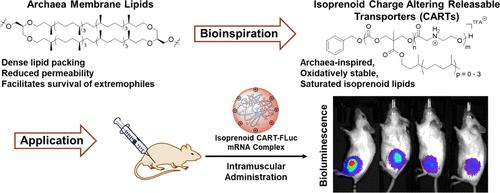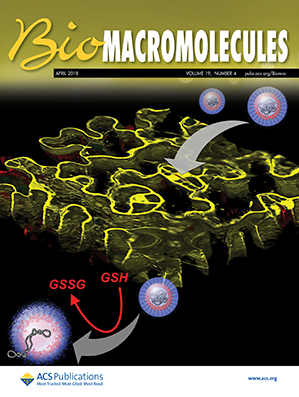异戊烯类 CARTs:用受古生菌启发的支链脂质功能化的电荷改变可释放转运体进行体外和体内 mRNA 运送。
IF 5.5
2区 化学
Q1 BIOCHEMISTRY & MOLECULAR BIOLOGY
引用次数: 0
摘要
在材料科学与医学的交界处,寡核苷酸的跨生物屏障输送是一项具有无与伦比意义的挑战,它在预防和治疗性疫苗接种、免疫疗法、基因组编辑和细胞年轻化方面具有新兴的临床用途。在这里,我们探讨了易于获得的支链脂质在设计、合成和评估异丙烯酸电荷改变可释放转运体(CARTs)中的作用,CARTs 是一种用于 RNA 的 pH 响应型低聚物纳米颗粒递送系统。脂质嵌段的系统变化揭示了脂质嵌段与多阳离子嵌段中和动力学之间的关系。意想不到的是,具有最小脂质侧链(异戊基-)的 CART iA21A11 被确定为体外转染永生化淋巴母细胞系的主要异戊基 CART。在小鼠模型中进行肌肉注射时,iA21A11-mRNA 复合物诱导的蛋白质表达水平高于我们之前的先导 CART ONA。异戊烯类 CART 是 RNA 疫苗和其他多聚阴离子疗法的新型递送平台。本文章由计算机程序翻译,如有差异,请以英文原文为准。


Isoprenoid CARTs: In Vitro and In Vivo mRNA Delivery by Charge-Altering Releasable Transporters Functionalized with Archaea-inspired Branched Lipids
The delivery of oligonucleotides across biological barriers is a challenge of unsurpassed significance at the interface of materials science and medicine, with emerging clinical utility in prophylactic and therapeutic vaccinations, immunotherapies, genome editing, and cell rejuvenation. Here, we address the role of readily available branched lipids in the design, synthesis, and evaluation of isoprenoid charge-altering releasable transporters (CARTs), a pH-responsive oligomeric nanoparticle delivery system for RNA. Systematic variation of the lipid block reveals an emergent relationship between the lipid block and the neutralization kinetics of the polycationic block. Unexpectedly, iA21A11, a CART with the smallest lipid side chain, isoamyl-, was identified as the lead isoprenoid CART for the in vitro transfection of immortalized lymphoblastic cell lines. When administered intramuscularly in a murine model, iA21A11-mRNA complexes induce higher protein expression levels than our previous lead CART, ONA. Isoprenoid CARTs represent a new delivery platform for RNA vaccines and other polyanion-based therapeutics.
- Download: Download high-res image (169KB)
- Download: Download full-size image
求助全文
通过发布文献求助,成功后即可免费获取论文全文。
去求助
来源期刊

Biomacromolecules
化学-高分子科学
CiteScore
10.60
自引率
4.80%
发文量
417
审稿时长
1.6 months
期刊介绍:
Biomacromolecules is a leading forum for the dissemination of cutting-edge research at the interface of polymer science and biology. Submissions to Biomacromolecules should contain strong elements of innovation in terms of macromolecular design, synthesis and characterization, or in the application of polymer materials to biology and medicine.
Topics covered by Biomacromolecules include, but are not exclusively limited to: sustainable polymers, polymers based on natural and renewable resources, degradable polymers, polymer conjugates, polymeric drugs, polymers in biocatalysis, biomacromolecular assembly, biomimetic polymers, polymer-biomineral hybrids, biomimetic-polymer processing, polymer recycling, bioactive polymer surfaces, original polymer design for biomedical applications such as immunotherapy, drug delivery, gene delivery, antimicrobial applications, diagnostic imaging and biosensing, polymers in tissue engineering and regenerative medicine, polymeric scaffolds and hydrogels for cell culture and delivery.
 求助内容:
求助内容: 应助结果提醒方式:
应助结果提醒方式:


